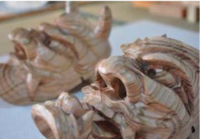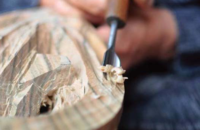

Total:131items
- Pottery & Porcelain (18)
- Lacquerware (4)
- Glasswork (2)
- Wood & Bamboo Work (19)
- Hakone Yosegi Zaiku: Hakone Marquetry
- Boshu Uchiwa: Boshu Fans
- Nikko-bori: Nikko carving
- Sasebo Koma (Sasebo Spinning Top)
- Shimoda Yanimatsu Zaiku (Shimoda Joinery of Oily Pine)
- Echizen Takeningyo (Bamboo Dolls)
- Osaka Senshu Kiri-dansu: Paulownia chest of drawers or wardrobes of Senshu, Osaka
- Kitayama Maruta: Japanese cedar logs
- Yodoegasa: Yodoe umbrella
- Atami Kusu Zaiku: Atami Camphor wood crafts
- Kawatsura Kokeshi Doll
- Itaya Zaiku: Itaya Bark Craft
- Yokohama Classic Furniture
- Hinaga Uchiwa: Hinaga Fan
- Torafu Takezaiku: Tiger Bamboo Work
- Tsuruzaiku: Woven Vine Craft
- Okawa Kumiko: Okawa Kumiko Wood Joinery
- Shuro Houki: Hemp-palm Broom
- Furyumen: Wood Carving Mask
- Leather Work (1)
- Papermaking (13)
- Textile (20)
- Dyeing products (5)
- Masonry (1)
- Metal Work (11)
- Stationery (4)
- Livingware (3)
- Accessory (4)
- Toys & Entertainment (14)
- Interior (2)
- Other crafts (10)

 |
Main Production Site:Saga |
 《Characteristics》
《Characteristics》“Furyumen” is a mask made by carving camphor trees (prefectural tree of Saga), paulownia, or hinoki (Japanese cypress) grow in Saga prefecture.The ogre mask carved with great care taking advantage of wood grain is full of beauty and dreadfulness. Recently, more people display the mask in their home as a talisman.
“Men Buryu (masked dance)”, handed down in the southwestern region of Saga prefecture, is a traditional performing art where dancers wear an ogre mask and dance vigorously to the rhythms of the flute, drum, and bell. The dance is essential in praying for abundant harvest, rainfall and dedicatory Shinto rituals. The mask used in the Men Buryu is called “Furyumen”.
The expressions of the “Furyumen” are slightly different by region, but all the masks make an a-un pair. A male mask has firmly pursed lips with upper teeth biting the lower lip to pronounce the sound “un”. Its characteristics are a pair of long horns on the head and U-shaped wrinkles on the forehead. A female mask, on the contrary, has a wide opened mouth with a tongue reached out to pronounce the sound “a”. Short horns and V-shaped wrinkles on the forehead feature the female mask.
[A Traditional Local Product Designated by Saga Prefecture]
Contents Provided: Saga Prefectural Government
Translation by Marie Mine, reviewed by Tham Wan Xin

| Materials | Camphor trees, paulownia, hinoki (Japanese cypress), etc. |
|---|---|
| Crafting Processes | There are two types of finishes, unpainted finish and painted finish, for a-un masks.
[1] Designing Decide a composition of the mask and draw carve lines on wood cut out in cuboid. [2] Cutting [3] Removing wood shavings [4] Rough cutting Roughly carve out the shape of the mask from the camphor wood. [5] Rough carving While carving out the outline of the mask, carve a tongue and a nose. Then, roughly carve lines of eyebrow and eyes. [6] Fine carving To finish carving, finely carve the details all over the surface of the mask. Carve out fierce expression using a small carving knife. ◎ Process of unpainted finish [7] Applying wax Melt wax with heat and apply it all over the mask. [8] Polishing When the mask is dry, polish it with cloth. [9] Attaching hair Attach hair to the mask to complete the process of unpainted finish. ◎ Process of painted finish [7] Sanding After the fine carving, sand the mask with a sandpaper. [8] Rough coating [9] Lacquering [10] Finish coating [11] Applying gold leaf [12] Drying [13] Attaching hair Attach hair to complete the process of painted finish. |
| History | The origin of “Furyumen” dates to the battle in Mitagawa-Cho, Kanzaki-gun (now Kanzaki City, Saga prefecture) around 1530 where Nabeshima Heiemon, the great general of Ryuzoji clan, fought and won the battle with his clan members wearing the ogre masks. They celebrated their victory by dancing with the masks on.
The oldest existing Furyumen is the ones in Iida and Yanoura areas in Kashima City and are estimated to have been made 250 to 300 years ago. It is thought that palace carpenters made the masks on requests from local people back then. Now, three craftsmen of two workshops in Kashima City inherit the techniques. |
◆Exhibition / Showcase
Yutoku Inari Shrine
Otsu 1855, Furueda, Kashima City, Saga, 849-1321 Japan
Telephone: +81(0)954-62-2151
Wood carving workshop Sugicho
Kou 1221-1, Furueda, Kashima City, Saga, 849-1321 Japan
Telephone: +81(0)954-62-9574
◆Event Information
Assistance needed? For inquiries in English:
JTCO Contact Form
Your inquiries will be forwarded by JTCO in Japanese to the organization you wish to contact.
*Please write the name of craft you wish to ask about.



